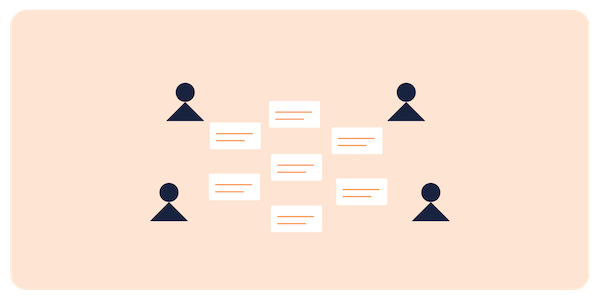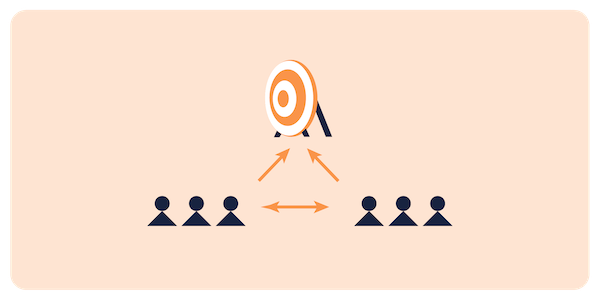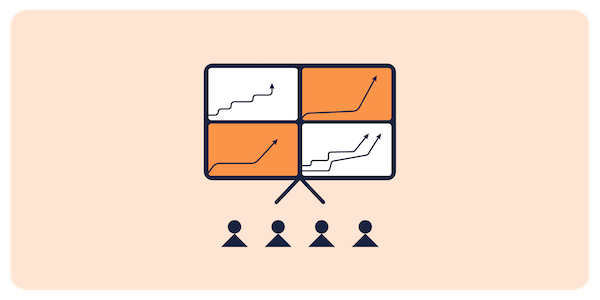Learn about purchasing for teams
The Synergy of OKRs and Scrum: A Powerful Combination

Combining the strategic clarity of OKRs (objectives and key results) with the execution excellence of scrum can unleash tremendous potential for organizations. This article illustrates how a company successfully integrates both frameworks, showcasing practical steps you can take to apply this dynamic duo in your own business.
Defining an OKR to implement strategy
Let’s imagine you’re working for a successful online ticketing platform that is branching out into merchandise. For the upcoming quarter, the decision is made to focus on selling band T-shirts. During a management retreat, the following OKR is established for the quarter:
- Objective: Position our platform as the leading destination for band T-shirts.
- Key Result: Sell 1,500 band T-shirts each week.

Aligning scrum teams' OKRs with the company’s OKR
Three weeks before the new quarter begins, management shares the company-wide OKR with everyone. Scrum teams then hold their own workshops with key stakeholders to define their respective OKRs that align with the overarching company objective.
Let’s take a look at the OKRs for two different teams: the website team and the marketing team.
- Website team:
- Objective: Inspire website visitors to buy T-shirts of their favorite bands.
- Key Results:
- 5% of ticket buyers also purchase a T-shirt.
- Customers complete their T-shirt purchase in under 5 clicks.
- Marketing team:
- Objective: Become the preferred site for those seeking band T-shirts.
- Key Results:
- 5,000 daily visitors searching for band T-shirts via search engines.
- 10,000 daily visitors driven by social media posts about band T-shirts.
Product backlog items to achieve OKRs
Once the team OKRs are set, the workshop continues with a brainstorming session facilitated by the scrum master. This session allows the team to come up with potential actions and backlog items that could help achieve the defined goals.
These backlog items are then prioritized based on expected value and speed of delivery. They don’t need to be fully detailed at this stage, as further refinement will take place over the quarter.
The iterative process of making changes, gathering data, and assessing results means new backlog items are highly likely to emerge as the quarter progresses.

Addressing cross-team dependencies
The marketing team identifies a need for collaboration with the website team. They want to create targeted ads and social media campaigns for specific band T-shirts, which require unique landing pages.
To address this, the product owner from the marketing team reaches out to the website team’s product owner. Together, they prioritize work at the top of the website team's product backlog will make it possible for the marketing team to create the landing pages. This collaboration ensures the marketing team can start their campaigns shortly after the first sprint of the quarter.
This collaboration also supports the website team’s key result: ensuring that when fans land on a page featuring their favorite band's T-shirt, the purchase process is seamless, thus improving the conversion rate (buying the T-shirt within 5 clicks).

Using sprint reviews to track key results progress
At the end of each sprint, the two teams conduct a joint sprint review to assess progress toward their key results. This shared review is particularly valuable as they serve the same set of stakeholders.
The website team showcases the new features they've rolled out during the sprint, such as the updated T-shirt purchase flow. They share the relevant metrics, including the percentage of ticket buyers also purchasing a T-shirt, and the average number of clicks required to complete the sale.
In the first three sprints, sales figures may be low because the website team initially focused on creating a minimum viable product (MVP) for just a few popular bands, optimizing usability first. They improved how to sell in a few clicks, and then more bands were added and sales gradually picked up.
The marketing team demonstrates the impact of their efforts, including the number of visitors they attracted through search engines and social media campaigns. They also present metrics, showing how many of those visitors were specifically interested in band T-shirts.
Embracing continuous improvement through retrospectives
At the conclusion of each sprint, both teams hold separate retrospectives. In addition, the entire company comes together at the end of the quarter for a joint retrospective facilitated by a scrum master.
During this session, teams identify the key areas that need improvement. They then break into smaller groups to dive deeper into specific issues. Afterward, the groups reconvene to share their findings, ultimately agreeing on actionable improvements for the next quarter.
At this example company, one key improvement identified in the retrospective was the installation of large screens throughout the office that display live statistics for the OKRs of all teams.

Next steps: Taking your organization to the next level
If your organization already uses OKRs to set quarterly goals, adding scrum teams with a bi-weekly cadence can significantly enhance execution. On the flip side, if your organization already operates with scrum teams but lacks a formal OKR framework, incorporating a quarterly OKR process can yield substantial benefits.
For organizations new to either framework, it takes time to adjust. Scrum teams typically need a few sprints to get up to speed, and organizations new to OKRs will find it takes a few quarterly cycles to fully optimize the process.
--
Ready to learn more about OKRs?
When you understand how to create OKRs and pursue those goals effectively, your agile team can align on focus and achieve great things. Learn how to work with this goalsetting framework in Scrum Alliance's microcredential course, Agile OKRs.











